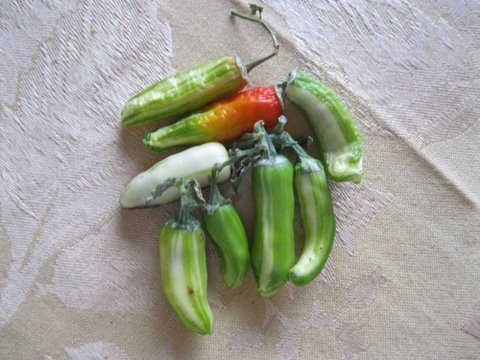Posts Tagged: peppers
Inter-planting Fruit Trees With Veggies
Yes, you can have it all in a relatively small back yard space: Fruit trees and veggies. Our “mini orchard” is on an oblong plot that’s about 25x15’, a sunny plot that came with the house we bought last summer. In that space there are 3 dwarf plums (Prunus spp.), 2 apricots (P. armeniaca), 3 cherry trees (P. avium), 2 peach trees (P. persica), and an apple (Malus domestica), all of unknown varieties. Our fruit trees are about 5 or 6 year old mostly dwarfs (I think), and if not, they got dwarfed anyway by my pruning saw and loppers last December, when I pruned both for shape and fruit production. My rule of thumb with fruit trees is that if it is higher than I can reach, it gets lopped off. This permits easy picking of the fruit and avoids the need for ladders. The pruning and thinning of the foliage, which I do about once per month (see photos) also allows more nutrients to get to the fruit, besides giving those veggies planted in between their 6-8 hours of sun.
The veggies we have include 6 tomato plants (Solanum lycopersicum) in cages, 2 clumps of squashes (Curcurbita pepo), Japanese eggplant (Solanum melongena), bell peppers (Capsicum annuum), a lemon cucumber (Cucumis sativus), 3 hollyhocks (Alcea setosa), and 2 sunflowers (Helianthus annuus). The tomatoes have been so productive we have to give the surplus to neighbors and friends. The eggplant and peppers have been slower to mature but nonetheless very tasty in stir-fries, especially with added portabella mushrooms (Agaricus bisporus) and fresh chard (Beta vulgaris), the chard grown in one of our raised beds in another location of the yard.
And so, another example of when less (space) is more (more intensively gardened).
UC Davis has a publication called The California Backyard Orchard, which you may find useful for tips on pruning, both in the dormant season in during the spring and summer months. See homeorchard.ucdavis.edu.
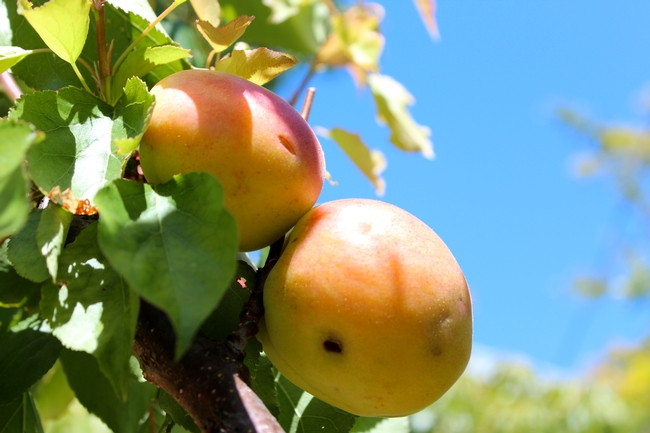
Apricot. (photos by Bud Veliquette)
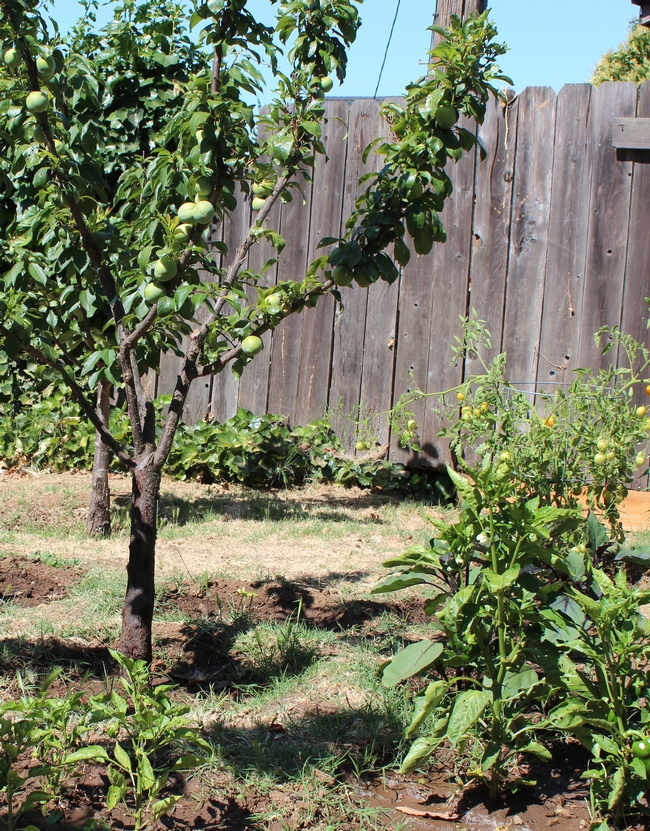
Apple tree, peppers and tomatoes.
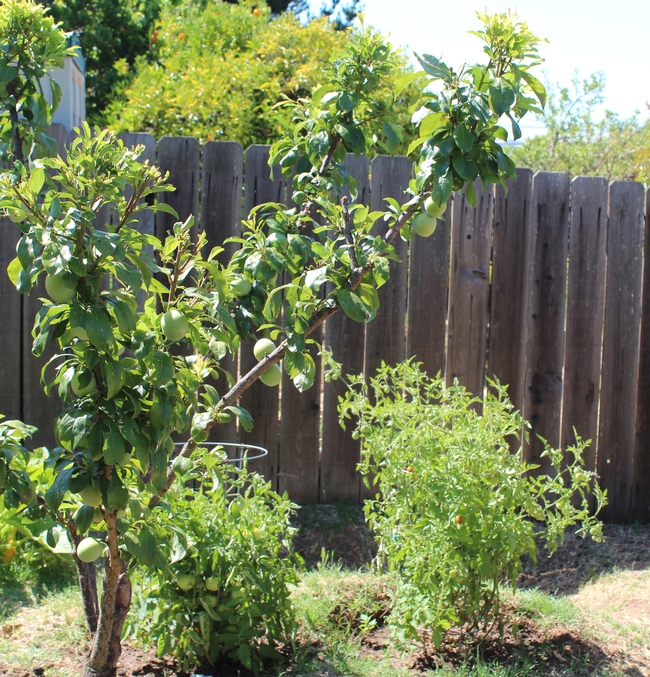
IMG 1082
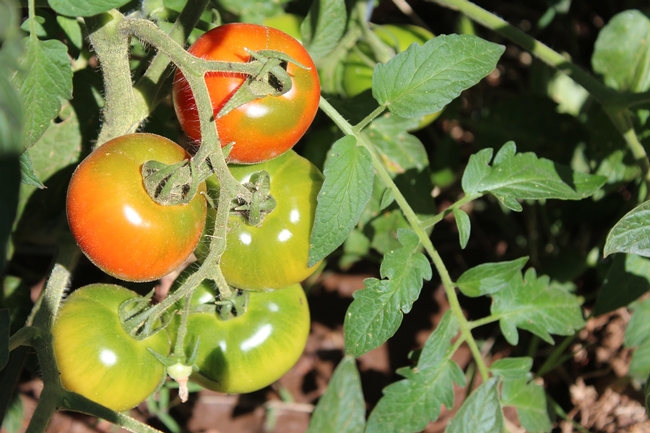
Vine-ripening tomatoes.
Fish Pepper Fish
One of the most striking peppers out there is an African-American heirloom fish pepper, Capsicum annuum. Its variegated green and white leaves with green and yellow striped peppers really stand out in a vegetable garden. The color of the fruit ranges from green, orange, brown, white, and red (watch out for the heat on the red). Mildly hot in the green form, these peppers can be used in many dishes, especially fish and shellfish dishes.
The pepper came to America in the 1870s and was widely grown in the Philadelphia and Baltimore areas. It is a secret ingredient in fish recipes, not showing up in cookbooks, but known through oral tradition.
Easy to grow in containers as well as raised and ground gardens, this pepper needs full sun, water 2-3 times per week until established, and mature in 80 days. Because of its handsome display, the plant is valued by ornamental landscapers.
You can get seeds from Baker Creek Heirloom Seeds; I ordered starters from Redwood Barn in Davis; Morningsun Herb Farm might also be able to order them.
One of my favorite fish dishes is grilled salmon, especially if I caught the salmon in Sitka, Alaska.
Grilled Salmon with Fish Peppers
2 salmon fillets
2-3 Tbsp olive oil
1/8-1/4 cup white wine
juice from 1 lemon or 1 orange
minced garlic to taste
salt and pepper to taste
minced fish pepper to taste
Marinade fillets in all ingredients for about 3 hours. Grill for 5-7 minutes on side depending on how well done you like your salmon. Enjoy.
Fresno takes another stab at agritourism
This weekend, agriculture, food and entertainment converge in Fresno when the city launches what organizers hope will be an annual Chili Pepper Festival, according to an article in the Fresno Bee.
The Fresno festival joins a host of agricultural festivals around the state, notably the Gilroy Garlic Festival, the Selma Raisin Festival, the Kingsburg Watermelon Festival, the Castroville Artichoke Festival and the Stockton Asparagus Festival. A chili pepper festival is particularly appropriate for Fresno, the Bee article said, since hot food and hot weather can be cleverly combined in a community that has its own namesake hot chili pepper.
The Fresno chili pepper is hotter than a jalapeño, savory and the centerpiece of Saturday's event. Usually red, but sometimes yellow and green, the name includes several varieties, UC Cooperative Extension farm advisor Manual Jimenez told Bee reporter Bethany Clough. Some varieties grow upward, with their skinny ends pointing toward the sky, Jimenez said.
Wikipedia reports that, because the Fresno chili is riper and redder than the jalapeño, it has more vitamin C. Fresno chilis are an excellent source of B vitamins, and contain significant amounts of iron, thiamin, niacin, magnesium and riboflavin. They are low in calories, fat and sodium.
Many small-scale growers include chilis as part of their vegetable production systems. A few years ago, Jimenez planted more than 200 varieties in plots at the UC Kearney Agricultural Research and Extension Center and invited farmers to observe for themselves which ones they might want to cultivate.
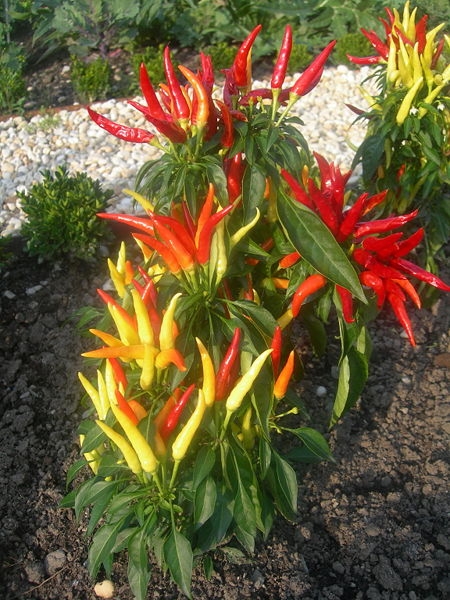
Chili peppers pointing skyward.
About Those Pickled Peppers
Peter Piper picked a peck of pickled peppers;A peck of pickled peppers Peter Piper picked;If Peter Piper picked a peck of pickled peppers,Where's the...

Foraging Honey Bee

Packing Pollen


